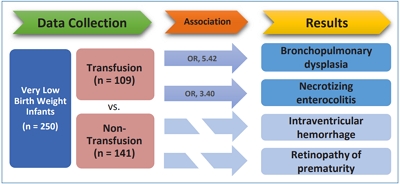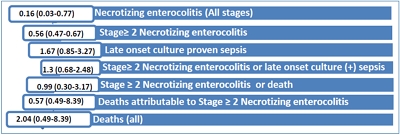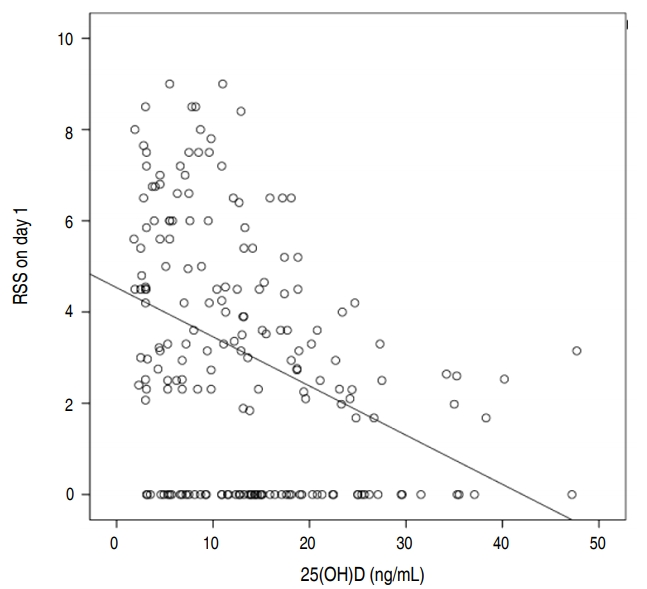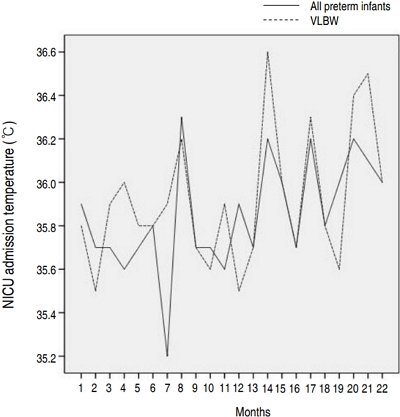Search
- Page Path
-
- HOME
- Search
- Review Article
- Neonatology (Perinatology)
- Neurodevelopmental outcomes of very low birth weight infants in the Neonatal Research Network of Japan: importance of neonatal intensive care unit graduate follow-up
- Yumi Kono; on behalf of the Neonatal Research Network of Japan
- Clin Exp Pediatr. 2021;64(7):313-321. Published online November 9, 2020
-

· Very low birth weight infants remain at high risk of developing neurodevelopmental impairments in early childhood.
· It is important to establish a network follow-up protocol and complete assessments with fewer dropouts to enable clarification of the outcomes of registered infants.
· All possible strategies should be employed to maintain good compliance after neonatal intensive care unit discharge.
- Original Article
- Neonatology (Perinatology)
- Effect of red blood cell transfusion on short-term outcomes in very low birth weight infants
- Eui Young Lee, Sung Shin Kim, Ga Young Park, Sun Hyang Lee
- Clin Exp Pediatr. 2020;63(2):56-62. Published online February 6, 2020
-

Question: Does RBC transfusion affect the short-term outcomes of VLBW infants?
Finding: The results showed that RBC transfusion was significantly related to the incidence of BPD (OR, 5.42; P<0.001) and NEC (OR, 3.40; P=0.009).
Meaning: Careful consideration of the patient’s clinical condition and appropriate guidelines is required before administering RBC transfusions.
- Review Article
- Neonatology (Perinatology)
- Short- and long-term outcomes of very low birth weight infants in Korea: Korean Neonatal Network update in 2019
- Jang Hoon Lee, YoungAh Youn, Yun Sil Chang; Korean Neonatal Network
- Clin Exp Pediatr. 2020;63(8):284-290. Published online February 5, 2020
-

The Korean Neonatal Network (KNN) has collected population-based data for very low birth weight infants (VLBWIs) born in Korea since 2013. The survival rate of all VLBWIs was 86% in Korea. The overall prevalence of cerebral palsy was 6.2%–6.6%. Bilateral blindness and hearing loss were reported in 0.2%–0.3%, 0.8%–1.9%, respectively. The KNN has published annual reports and papers for facilitating the improvement of VLBWIs outcome in Korea.
- Original Article
- Neonatology (Perinatology)
- Synbiotics use for preventing sepsis and necrotizing enterocolitis in very low birth weight neonates: a randomized controlled trial
- Ozge Serce Pehlevan, Derya Benzer, Tugba Gursoy, Guner Karatekin, Fahri Ovali
- Clin Exp Pediatr. 2020;63(6):226-231. Published online February 5, 2020
-

Background: Probiotics and prebiotics have strain-specific effects on the host. Synbiotics, a mixture of probiotics and prebiotics, are proposed to have more beneficial effects on the host than either agent has alone.
Purpose: We performed a randomized controlled trial to investigate the effect of Lactobacillus and Bifidobacterium together with oligosaccharides and lactoferrin on the development of necrotizing enterocolitis (NEC) or sepsis...
- Association between vitamin D level at birth and respiratory morbidities in very-low-birth-weight infants
- Ian Kim, Sung Shin Kim, Jee In Song, Seock Hwa Yoon, Ga Young Park, Yong-Wha Lee
- Clin Exp Pediatr. 2019;62(5):166-172. Published online October 24, 2018
-

Purpose: This study aimed to evaluate vitamin D status at birth in very-low-birth-weight infants (VLBWIs: <1,500 g) and to determine the association between vitamin D level and respiratory morbidity. Methods: A retrospective study was conducted at Soonchunhyang University Bucheon Hospital between November 2013 and November 2017. We collected blood samples and data on respiratory morbidity from 230 VLBWIs on the first...
- The impact of a quality improvement effort in reducing admission hypothermia in preterm infants following delivery
- Han Saem Choi, Soon Min Lee, Hoseon Eun, Minsoo Park, Kook-In Park, Ran Namgung
- Clin Exp Pediatr. 2018;61(8):239-244. Published online August 15, 2018
-

Purpose: Hypothermia at admission is associated with increased mortality and morbidity in preterm infants. We performed a quality improvement (QI) effort to determine the impact of a decrease in admission hypothermia in preterm infants. Methods: The study enrolled very low birth weight (VLBW) infants born at Gangnam Severance Hospital between January 2013 and December 2016. This multidisciplinary QI effort included the...
- Postdischarge growth assessment in very low birth weight infants
- Joon-Sik Park, Jungho Han, Jeong Eun Shin, Soon Min Lee, Ho Seon Eun, Min-Soo Park, Kook-In Park, Ran Namgung
- Clin Exp Pediatr. 2017;60(3):64-69. Published online March 27, 2017
-
Purpose The goal of nutritional support for very-low-birth-weight (VLBW) infants from birth to term is to match the
in utero growth rates; however, this is rarely achieved.Methods We evaluated postdischarge growth patterns and growth failure in 81 Korean VLBW infants through a retrospective study. Weight and height were measured and calculated based on age percentile distribution every 3 months until age 24...
- Modification of nutrition strategy for improvement of postnatal growth in very low birth weight infants
- Ah Young Choi, Yong Wook Lee, Mea-young Chang
- Clin Exp Pediatr. 2016;59(4):165-173. Published online April 30, 2016
-
Purpose To identify the effects of modified parenteral nutrition (PN) and enteral nutrition (EN) regimens on the growth of very low birth weight (VLBW) infants.
Methods The study included VLBW infants weighing <1,500 g, admitted to Chungnam National University Hospital between October 2010 and April 2014, who were alive at the time of discharge. Subjects were divided according to 3 periods: period 1...
- Case Report
- Neonatology (Perinatology)
- Successfully treated infective endocarditis caused by methicillin-resistant
Staphylococcus Aureus in extremely low birth weight infant - Sehwa Jung, Kyung Uk Jeong, Jang Hoon Lee, Jo Won Jung, Moon Sung Park
- Clin Exp Pediatr. 2016;59(2):96-99. Published online February 29, 2016
-
Survival rates of preterm infants have improved in the past few decades, and central venous catheters play an important role in the intensive medical treatment of these neonates. Unfortunately, these indwelling catheters increase the risk of intracardiac thrombosis, and they provide a nidus for microorganisms during the course of septicemia. Herein, we report a case of persistent bacteremia due to...
- Original Article
- Thyroid dysfunction in very low birth weight preterm infants
- Ji Hoon Lee, Sung Woo Kim, Ga Won Jeon, Jong Beom Sin
- Clin Exp Pediatr. 2015;58(6):224-229. Published online June 22, 2015
-
Purpose Thyroid dysfunction is common in preterm infants. Congenital hypothyroidism causes neurodevelopmental impairment, which is preventable if properly treated. This study was conducted to describe the characteristics of thyroid dysfunction in very low birth weight infants (VLBWIs), evaluate risk factors of hypothyroidism, and suggest the reassessment of thyroid function with an initially normal thyroid-stimulating hormone (TSH) as part of a newborn...
- Postnatal weight gain in the first two weeks as a predicting factor of severe retinopathy of prematurity requiring treatment
- Jongmoon Kim, Jang Yong Jin, Sung Shin Kim
- Clin Exp Pediatr. 2015;58(2):52-59. Published online February 28, 2015
-
Purpose This study aimed to investigate the relative weight gain at 2-week intervals up to 6 weeks after birth to predict retinopathy of prematurity (ROP) requiring treatment among very low birth weight infants.
Methods A total of 211 preterm infants with birth weights <1,500 g and gestational age <32 weeks were retrospectively reviewed. The main outcome was the development of ROP requiring treatment....
- Analysis of the association between necrotizing enterocolitis and transfusion of red blood cell in very low birth weight preterm infants
- Seon-Yeong Bak, Sihyoung Lee, Jae-Hong Park, Kyu-Hee Park, Ji-Hyun Jeon
- Clin Exp Pediatr. 2013;56(3):112-115. Published online March 18, 2013
-
Purpose To investigate the association between necrotizing enterocolitis (NEC) and red blood cell transfusions in very low birth weight (VLBW) preterm infants.
Methods We studied were 180 VLBW preterm infants who were admitted to the neonatal intensive care unit of CHA Gangnam Hospital from January of 2006 to December of 2009. The subjects were divided into 2 groups: an NEC group (greater than...
- The control of invasive
Candida infection in very low birth weight infants by reduction in the use of 3rd generation cephalosporin - Yu Jin Chang, Il Rak Choi, Won Sub Shin, Jang Hoon Lee, Yun Kyung Kim, Moon Sung Park
- Clin Exp Pediatr. 2013;56(2):68-74. Published online February 25, 2013
-
Purpose To evaluate the effectiveness of new management policies on the incidence of invasive Candida infections
Methods This observational study involved a retrospective analysis of the patients' medical records. In total, 99 very low birth weight infants, who were admitted to the neonatal intensive care unit at Ajou University Hospital from January 2010 to December 2011, were enrolled for the study. Period I,...
- Review Article
- The changing trends in live birth statistics in Korea, 1970 to 2010
- Jae Woo Lim
- Clin Exp Pediatr. 2011;54(11):429-435. Published online November 30, 2011
-
Although Korean population has been growing steadily during the past four decades, the nation is rapidly becoming an aging society because of its declining birth rate combined with an increasing life expectancy. In addition, Korea has one of the lowest fertility rates in the world due to fewer married couples, advanced maternal age, and falling birth rate. The prevalence of...
- Original Article
- Outcomes of small for gestational age micropremies depending on how young or how small they are
- Hee Joon Yu, Eun Sun Kim, Jin Kyu Kim, Hye Soo Yoo, So Yoon Ahn, Yun Sil Chang, Won Soon Park
- Clin Exp Pediatr. 2011;54(6):246-252. Published online June 30, 2011
-
Purpose The outcomes of small for gestational age (SGA) infants especially in extremely low birth weight infants (ELBWIs) are controversial. This study evaluated the mortality and morbidity of ELBWIs, focusing on whether or not they were also SGA.
Methods The medical records of 415 ELBWIs (birth weight <1,000 g), who were inborn and admitted to the Samsung Medical Center neonatal intensive care unit...
- Case Report
- Testicular torsion in the inguinal region in an extremely low birth weight infant
- Yu Jin Jung, Jae Min Chung
- Clin Exp Pediatr. 2010;53(9):852-854. Published online September 13, 2010
-
Testicular torsion is rare in newborn infants. However, its frequency has increased, most of which are reported in full-term infants. We diagnosed and treated testicular torsion in an extremely low birth weight infant (ELBWI). A 2×2 cm red mass was palpable in the left groin of a 24-week-old, 745 g, male newborn at 23 days of age. Left testicular torsion...
- Original Article
- Effect of severe neonatal morbidities on long term outcome in extremely low birthweight infants
- Kyo Yeon Koo, Jeong Eun Kim, Soon Min Lee, Ran Namgung, Min Soo Park, Kook In Park, Chul Lee
- Clin Exp Pediatr. 2010;53(6):694-700. Published online June 23, 2010
-
Purpose To assess the validity of individual and combined prognostic effects of severe bronchopulmonary dysplasia (BPD), brain injury, retinopathy of prematurity (ROP), and parenteral nutrition associated cholestasis (PNAC).
Methods We retrospectively analyzed the medical records of 80 extremely low birthweight (ELBW) infants admitted to the neonatal intensive care unit (NICU) of the Severance Children's Hospital, and who survived to a postmenstrual age of...
- Changes in the outcomes of neonatal intensive care unit at a single center over 12 years
- Hyun-Hee Lee, Tae-Yeon Kim, Seon-Hee Shin, Tae-Jung Sung
- Clin Exp Pediatr. 2009;52(8):881-887. Published online August 15, 2009
-
Purpose:The survival rate of very low birth weight infant (VLBWI) had increased as a result of advances in neonatal intensive care. We evaluated the changes in outcomes of VLBWI who admitted to the neonatal care unit of Hallym University Kangnam Sacred Heart Hospital. Methods:Retrospective review of 339 VLBWI who were born from 1st January 1997 to 31th December 2008 were performed. Outcomes including survival... -
- Growth and clinical efficacy of fortified human milk and premature formula on very low birth weight infants
- Heewon Chueh, Myo Jing Kim, Young-A Lee, Jin-A Jung
- Clin Exp Pediatr. 2008;51(7):704-712. Published online July 15, 2008
-
Purpose : A prospective, controlled trial was conducted to evaluate growth, efficacy, safety and nutritional status for very low birth weight infants fed with human milk fortified with Maeil human milk fortifier (Maeil HMF ; Maeil Dairies Co., Ltd.). Methods : We enrolled 45 premature infants with a birth weight <1,500 g and gestational age <33 weeks, who were born at... -
- Review Article
- Trends in survival rate for very low birth weight infants and extremely low birth weight infants in Korea, 1967-2007
- Ki-Soo Kim, Chung-Woo Bae
- Clin Exp Pediatr. 2008;51(3):237-242. Published online March 15, 2008
-
To investigate the trends in the survival rate (SR) for very low birth weight infants (VLBW) and extremely low birth weight infants (ELBWI) in Korea, a total of 43 articles pertaining to SR were analyzed, covering the years from 1967 to 2007. The changes in SR were compared using 5 year periods. The SR for VLBWI has increased remarkably, from... -
- Changes in birth rates of low birth weight and premature infants in Korea over the past 7 years
- Min Hee Kim
- Clin Exp Pediatr. 2008;51(3):233-236. Published online March 15, 2008
-
In recent years, Korea has experienced a steadily declining birth rate, which is a serious social problem in the country. Although living conditions have improved, the birth rates for low birth weight infants and preterm babies has increased because more and more women choose to give birth later in life and the social environment has changed. The rise in low... -
- Original Article
- Platelet count and mean platelet volume in low birth weight infants (≤2,000 g) with sepsis
- Wan-soo Lee, Jin-young Cho, Seung-taek Yoo, Chang-woo Lee, Doo-young Choi, Jong-duck Kim, Yeon-kyun Oh
- Clin Exp Pediatr. 2007;50(7):643-648. Published online July 15, 2007
-
Purpose : Sepsis is a common complication in Neonatal Intensive Care Units (NICU), seen especially in low birth weight (LBW) infants. A recent study showed that fungal or gram-negative sepsis is associated with a greater degree of thrombocytopenia than is seen with gram-positive sepsis. So, this study was undertaken to examine the platelet counts and platelet indices in LBW infants... -
- Fluconazole prophylaxis in high-risk, very low birth weight infants
- Soo Young Kim, Soon Joo Lee, Mi Jeong Kim, Eun Song Song, Young Youn Choi
- Clin Exp Pediatr. 2007;50(7):636-642. Published online July 15, 2007
-
Purpose : Fluconazole prophylaxis for very low birth weight (VLBW) infants has been shown to reduce invasive fungal infection and its mortality. This study aims to evaluate the effect of fluconazole prophylaxis in VLBW infants on the incidence and mortality of fungal infection. Methods : VLBW infants with endotracheal intubation and central vascular access admitted to the Neonatal Intensive Care... -
- Comparison of total parenteral nutrition-associated cholestasis according to amino acid mixtures in very low birth weight infants
- Jin-Sung Choi, Yun-Jin Bae, Young Ah Lee
- Clin Exp Pediatr. 2006;49(9):972-976. Published online September 15, 2006
-
Purpose : The purpose of this study was to evaluate the effect of amino acid mixtures on incidence and severity of total parenteral nutrition associated-cholestasis(PNAC) in very low birth weight infants. Methods : Retrospective review of 63 very low birth weight infants(birth weight ≤1,500 g) who received total parenteral nutrition(TPN) in our neonatal intensive care unit from January 2000 to... -
- Effect of prophylactic indomethacin in extremely low birth weight infants
- Bo Lyun Lee, Su Jin Kim, Soo Hyun Koo, Ga Won Jeon, Yun Sil Chang, Won Soon Park
- Clin Exp Pediatr. 2006;49(9):959-965. Published online September 15, 2006
-
Purpose : The purpose of this study was to investigate the effect of prophylactic indomethacin on reduction of patent ductus arteriosus(PDA) and intraventricular hemorrhage(IVH) in extremely low birth weight infants(ELBWI). Methods : Retrospective review of 84 ELBWI who were admitted to our neonatal intensive care unit from June 2004 to April 2006 was performed. Patients were divided into prophylactic group(n=28) and... -
- Recent outcome of extremely low birth weight infants - The use of CRIB(clinical risk index for babies) Ⅱ score foranalyzing the survival rate -
- Do-Hyeon Kim, So-Yeon Shim, Jae-Ri Kim, Seung-Han Shin, Eun Sun Kim, Kyoung-Eun Joung, Sang Duk Kim, Jin A Lee, Chang Won Choi, Ee-Kyung Kim, Han-Suk Kim, Beyong Il Kim, Jung-Hwan Choi
- Clin Exp Pediatr. 2006;49(9):952-958. Published online September 15, 2006
-
Purpose : The survival rate of infants weighing less than 1,000 g at birth(extremely low birth weight infants, ELBWI) has increased due to recent advances in perinatal and neonatal intensive care. The purpose of this study was to evaluate the survival rates of ELBWI born at Seoul National University Hospital during the last six years. Methods : A total of... -
- Immune responses of hepatitis B vaccination among very low birth weight infant
- Young-Deuk Kim, Myung-Ki Han, Ai-Rhan E. Kim, Ki-Soo Kim, Soo-Young Pi
- Clin Exp Pediatr. 2006;49(8):857-863. Published online August 15, 2006
-
Purpose : To evaluate the immunogenicity of hepatitis B vaccine among very low birth weight infants(VLBWI) who were vaccinated at 0, 1, 6 months of chronological age and to determine the factors associated with antibody formations. Methods : A total of 243 VLBWI admitted to Seoul and Gangneung Asan Medical Center neonatal intensive care units from 1997 to 2004 were... -
- Catch-up growth and development of very low birth weight infants
- Tae Ho Ma, Kyung Ah Kim, Sun Young Ko, Yeon Kyung Lee, Son Moon Shin
- Clin Exp Pediatr. 2006;49(1):29-33. Published online January 15, 2006
-
Purpose : The aim of this study was to analyze the results and contributing factors of catch-up growth in very low birth weight infants(VLBWI) at the corrected age of 2 years. In addition, we looked for a relationship between the catch-up growth and the development by the bayley scales of infant development II(BSID II). Methods : A retrospective analysis by... -
- Clinical Use and Complications of Percutaneous Central Venous Catheterization in Very Low Birth Weight Infants
- Hyang Kim, Sun Hui Kim, Hyung Suck Byun, Young Youn Choi
- Clin Exp Pediatr. 2005;48(9):953-959. Published online September 15, 2005
-
Purpose : The administration of total parenteral nutrition(TPN) has become a standard procedure in the management of nutritionally deprived and critically low birth weight neonates. Sepsis remains the most frequent serious complication during TPN, resulting in increased morbidity, mortality and health care costs. This study was performed to evaluate the clinical efficacy and complications of percutaneous central venous catheterization(PCVC) in... -
- The Effects of Early Enteral Feeding in Extremely Low Birth-Weight Infants
- Ga Won Jeon, Sung Eun Park, Chang Won Choi, Jong Hee Hwang, Yun Sil Chang, Won Soon Park
- Clin Exp Pediatr. 2005;48(7):711-715. Published online July 15, 2005
-
Purpose : With the recent improved survival of extremely low birth weight infants(ELBWI), enteral feeding has become a major issue. This study investigates the effects of early enteral feeding in ELBWI on their morbidity, duration of hospitalization, and mortality. Methods : ELBWI admitted to the neonatal intensive care unit at Samsung Medical Center from November 1994 to April 2004 who survived... -
-

-
-
8.02023CiteScore94th percentilePowered by
-
Impact Factor3.2
-
- TOPICS
- ARTICLE CATEGORY
- Editorial Office
-
Korean Pediatric Society
#1606 Seocho World Officetel, 19 Seoun-ro, Seocho-ku, Seoul 06732, Korea
Tel: +82-2-3473-7306 Fax: +82-2-3473-7307 E-mail: office@e-cep.org
Clinical and Experimental Pediatrics is an open access journal. All articles are distributed under the terms of the Creative Commons Attribution NonCommercial License (http://creativecommons.org/licenses/by-nc/4.0/)
Copyright © 2025 by Korean Pediatric Society.











